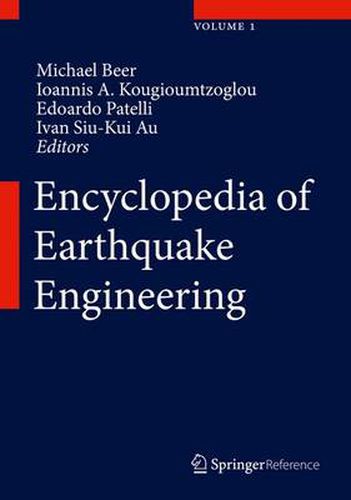Readings Newsletter
Become a Readings Member to make your shopping experience even easier.
Sign in or sign up for free!
You’re not far away from qualifying for FREE standard shipping within Australia
You’ve qualified for FREE standard shipping within Australia
The cart is loading…






The Encyclopedia of Earthquake Engineering is designed to be the authoritative and comprehensive reference covering all major aspects of the science of earthquake engineering, specifically focusing on the interaction between earthquakes and infrastructure. The encyclopedia comprises approximately 265 contributions. Since earthquake engineering deals with the interaction between earthquake disturbances and the built infrastructure, the emphasis is on basic design processes important to both non-specialists and engineers so that readers become suitably well-informed without needing to deal with the details of specialist understanding. The content of this encyclopedia provides technically inclined and informed readers about the ways in which earthquakes can affect our infrastructure and how engineers would go about designing against, mitigating and remediating these effects. The coverage ranges from buildings, foundations, underground construction, lifelines and bridges, roads, embankments and slopes. The encyclopedia also aims to provide cross-disciplinary and cross-domain information to domain-experts. This is the first single reference encyclopedia of this breadth and scope that brings together the science, engineering and technological aspects of earthquakes and structures.
$9.00 standard shipping within Australia
FREE standard shipping within Australia for orders over $100.00
Express & International shipping calculated at checkout
The Encyclopedia of Earthquake Engineering is designed to be the authoritative and comprehensive reference covering all major aspects of the science of earthquake engineering, specifically focusing on the interaction between earthquakes and infrastructure. The encyclopedia comprises approximately 265 contributions. Since earthquake engineering deals with the interaction between earthquake disturbances and the built infrastructure, the emphasis is on basic design processes important to both non-specialists and engineers so that readers become suitably well-informed without needing to deal with the details of specialist understanding. The content of this encyclopedia provides technically inclined and informed readers about the ways in which earthquakes can affect our infrastructure and how engineers would go about designing against, mitigating and remediating these effects. The coverage ranges from buildings, foundations, underground construction, lifelines and bridges, roads, embankments and slopes. The encyclopedia also aims to provide cross-disciplinary and cross-domain information to domain-experts. This is the first single reference encyclopedia of this breadth and scope that brings together the science, engineering and technological aspects of earthquakes and structures.